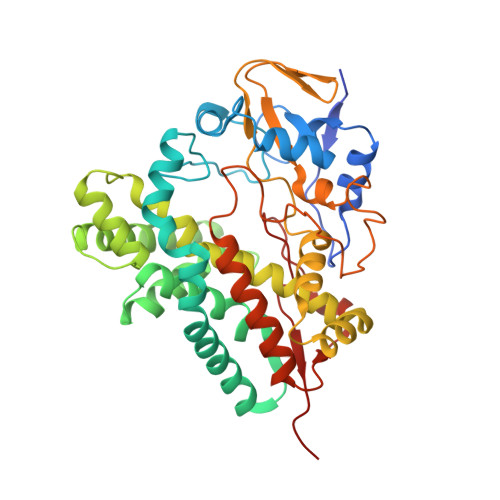Different binding modes of two flaviolin substrate molecules in cytochrome P450 158A1 (CYP158A1) compared to CYP158A2.
Zhao, B., Lamb, D.C., Lei, L., Kelly, S.L., Yuan, H., Hachey, D.L., Waterman, M.R.(2007) Biochemistry 46: 8725-8733
- PubMed: 17614370
- DOI: https://doi.org/10.1021/bi7006959
- Primary Citation of Related Structures:
2DKK, 2NZ5, 2NZA - PubMed Abstract:
Cytochrome P450 158A2 (CYP158A2) has been shown to catalyze an unusual oxidative C-C coupling reaction to polymerize flaviolin and form highly conjugated pigments (three isomers of biflaviolin and one triflaviolin) in Streptomyces coelicolor A3(2) which protect the soil bacterium from deleterious effects of UV irradiation (Zhao B. et al. (2005) J. Biol. Chem. 280, 11599-11607). The present studies demonstrate that the subfamily partner CYP158A1, sharing 61% amino acid identity with CYP158A2, can also catalyze the same flaviolin dimerization reactions, but it generates just two of the three isomers of biflaviolin that CYP158A2 produces. Furthermore, the two CYP158A1 products have very different molar ratios compared with the corresponding CYP158A2 products, indicating that each enzyme maintains its own stereo- and regiospecificity. To find an explanation for these differences, three CYP158A1 structures have been solved by X-ray crystallography and have been compared with those for CYP158A2. The structures reveal surprising differences. Particularly, only one flaviolin molecule is present close to the heme iron in CYP158A1, and the second flaviolin molecule binds at the entrance of the putative substrate access channel on the protein distal surface 9 A away. Our work describes two members of the same P450 subfamily, which produce the same products by oxidative C-C coupling yet show very different structural orientations of substrate molecules in the active site.
Organizational Affiliation:
Department of Biochemistry, Vanderbilt University School of Medicine, Nashville, Tennessee 37232-0146, USA. bin.zhao@vanderbilt.edu
















